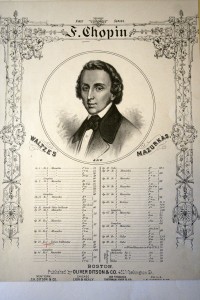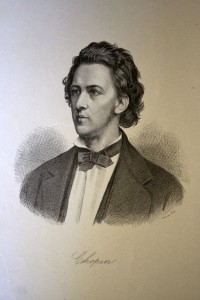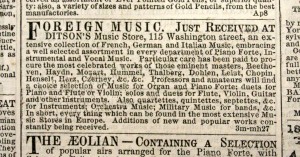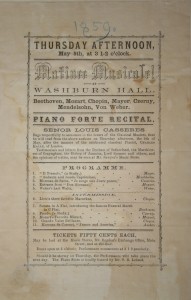March 1, 2010 marks the 200th anniversary of the birth of the pianist composer Frédéric François Chopin (1810-1849). Chopin was born near Warsaw and lived much of his short life in France so you may be asking yourself why on earth there is a post about him on the blog of the American Antiquarian Society. Last week, after hearing a NPR story about the concerts and events marking Chopin’s birth, how most of him is buried in Paris but his heart is in a shrine in Warsaw, how his music is closely associated with the Romantic movement, etc., etc., I initiated a discussion behind the reference desk over whether or not Chopin was as revered during his lifetime here in the United States as he was in Europe. There were several ways to find out, we decided, and so we split up to dig through the stacks and our on-line resources to see what we could find.

A search of the American sheet music collection turned up numerous examples of Chopin’s works, including some which, according to resident music expert Andrew Bourque, had been simplified for more amateur players. Most are lithographed scores and it is interesting to note that the composer began his career just as the sheet music industry was switching from engraving to lithography as the preferred mode of reproduction and distribution of music. All of the songs in our collection were printed in the United States, and most date from just after the composer’s death or later, so this evidence certainly supported the fact that Chopin had a following here in the latter portion of the century. But what about during his lifetime, when he was entertaining the elite of Europe?
The print collection turned up two portraits of Chopin, both dating from after his death at the young age of thirty-nine.  These images indicate that the lithographers of New York and Philadelphia thought there was a market for images of the Romantic musician, but it doesn’t tell us what the composer’s reception might have been here before 1849. A check of other institutional holdings of prints supports this – with most of the American images of Chopin dating from after 1850. A quick check of the nation’s painted and sculptural holdings indexed by the Smithsonian American Inventories Resource (http://sirismm.si.edu/siris/aboutari.htm) revealed only five busts of Chopin, all from after 1900. For comparison, Beethoven returned nearly forty results, many from the nineteenth century.
These images indicate that the lithographers of New York and Philadelphia thought there was a market for images of the Romantic musician, but it doesn’t tell us what the composer’s reception might have been here before 1849. A check of other institutional holdings of prints supports this – with most of the American images of Chopin dating from after 1850. A quick check of the nation’s painted and sculptural holdings indexed by the Smithsonian American Inventories Resource (http://sirismm.si.edu/siris/aboutari.htm) revealed only five busts of Chopin, all from after 1900. For comparison, Beethoven returned nearly forty results, many from the nineteenth century.
What else? The first biography of Chopin published in the United States was a translation of Liszt’s 1852 biography, printed in Boston and Philadelphia in the 1860s. Concert programs and broadsides in the Society’s holdings list performers playing his work in the 1850s (listing him third, after Beethoven and Mozart, not too shabby!). Andrew checked periodicals and turned up an article about Chopin published in April of 1850 in the New York periodical The eclectic magazine of foreign literature, science, and art. The article was reprinted from a London magazine, so the content has a very European slant, but the fact that the lengthy article found an audience here is still interesting.
Reference assistant Ashley Cataldo went digging in the on-line resources and found a wonderful 1988 article on the American transcendental critic Margaret Fuller (1810-1850) and her response to the music scene in Boston during the 1840s. Writing for the New-York Daily Tribune in January of 1846, Fuller commented on the upcoming U.S. debut concert of the European pianist Julian Fontana (1810-1869). She hoped that his playing would translate, “the fire and sweep of Liszt, the architectural majesty of Thalberg, and the tenderness and delicate fancy of Chopin” (Quoted in Ora Frishberg Saloman, “Margaret Fuller on Musical Life in Boston and New York, 1841-1846,” American Music, Vol. 6, No. 4 (Winter, 1988), pp. 428-441, p. 437). Ah, now we have something concrete. Chopin’s music was certainly being played and heard in America during his lifetime and, at least according to the worldly Fuller, he was a force on the level of Franz Liszt and Sigismond Thalberg.
Additionally, Ashley located several 1845 advertisements in the Boston Daily Atlas for Oliver Ditson’s music shop in Boston which include references to Chopin’s songs being sold. A broadside published c. 1844 for competing music dealer John Ashton & Co., also of Boston, lists Chopin’s songs being sold with other “foreign” tunes. So Chopin’s music was available for sale before his death in multiple shops in Boston.


So what did we learn from our little exercise? Probably those in the know, like Fuller and the music store owners, were aware of Chopin and maybe even understood his dawning influence on piano music during this period. We know that after the young composer’s death his music became widely available and his image begins to circulate in this country. He was not, apparently, the “rock star” personality that he was in Europe, as his work is not mentioned in the wider press nor is there much information on his unconventional personal life (I’d love to be a fly on the wall with George Sands and Margaret Fuller in the same room — anyone else?). In contrast, the British and French press tracked the composer’s travels, commented frequently on his reclusive nature, and noted the scandals associated with Sands later novels and her relationship with Chopin. Americans were not so focused on Chopin until much later.
Here in the States, his work is just starting to be widely played in the late 1850s, right before the Civil War. And during the war, he pretty much disappears, understandably, until the 1870s. It is hard to imagine his soft, complex, romantic music competing with the blast of cannon fire and sometimes shrill patriotic tunes that were flooding the ears of Americans from 1858 to 1865. His nocturnes and etudes would have seemed very foreign and very far removed.

Julian Fontana(www.julianfontana.com) performed music of Chopin many times in the United States and Cuba. After leaving Paris Fontana went to Cuba where he introduced Chopin’s music to the many lovers of music of the Spanish elite on the island. Fontana left Cuba after a romantic affair and proceeded to New York City where he performed many concerts which are well documented in Strong on Music by Vera Brodsky Lawrence.
I am researching Chopin’s Songs Opus 74 published by Oliver Ditson and would be interested in any information you might have about them.
Mr. Rodriguez, We do not have a printing of Chopin’s Op. 74 printed by Oliver Ditson. You might want to check the Sheet Music Consortium at http://digital2.library.ucla.edu/sheetmusic/ to see if you can locate a library that holds this printing.
The Chopin Songs were published by Oliver Ditson under the title “16 Polish Songs by F. Chopin”. They were published in 1862.